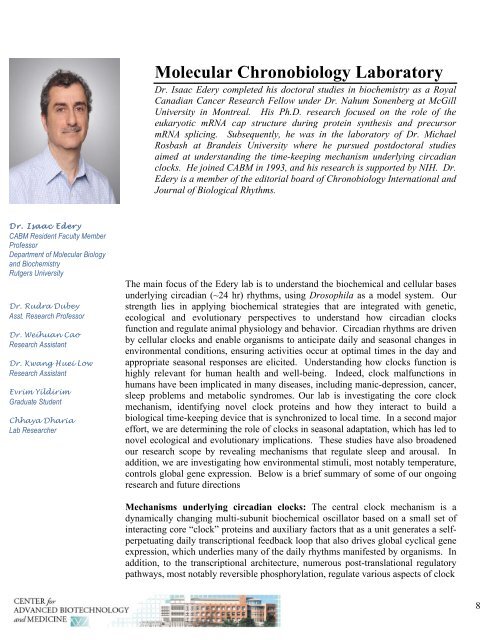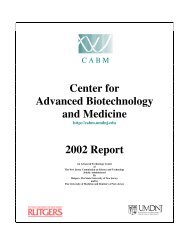Annual Report 2011 - Center for Advanced Biotechnology and ...
Annual Report 2011 - Center for Advanced Biotechnology and ...
Annual Report 2011 - Center for Advanced Biotechnology and ...
You also want an ePaper? Increase the reach of your titles
YUMPU automatically turns print PDFs into web optimized ePapers that Google loves.
Dr. Isaac Edery<br />
CABM Resident Faculty Member<br />
Professor<br />
Department of Molecular Biology<br />
<strong>and</strong> Biochemistry<br />
Rutgers University<br />
Dr. Rudra Dubey<br />
Asst. Research Professor<br />
Dr. Weihuan Cao<br />
Research Assistant<br />
Dr. Kwang Huei Low<br />
Research Assistant<br />
Evrim Yildirim<br />
Graduate Student<br />
Chhaya Dharia<br />
Lab Researcher<br />
Molecular Chronobiology Laboratory<br />
Dr. Isaac Edery completed his doctoral studies in biochemistry as a Royal<br />
Canadian Cancer Research Fellow under Dr. Nahum Sonenberg at McGill<br />
University in Montreal. His Ph.D. research focused on the role of the<br />
eukaryotic mRNA cap structure during protein synthesis <strong>and</strong> precursor<br />
mRNA splicing. Subsequently, he was in the laboratory of Dr. Michael<br />
Rosbash at Br<strong>and</strong>eis University where he pursued postdoctoral studies<br />
aimed at underst<strong>and</strong>ing the time-keeping mechanism underlying circadian<br />
clocks. He joined CABM in 1993, <strong>and</strong> his research is supported by NIH. Dr.<br />
Edery is a member of the editorial board of Chronobiology International <strong>and</strong><br />
Journal of Biological Rhythms.<br />
The main focus of the Edery lab is to underst<strong>and</strong> the biochemical <strong>and</strong> cellular bases<br />
underlying circadian (~24 hr) rhythms, using Drosophila as a model system. Our<br />
strength lies in applying biochemical strategies that are integrated with genetic,<br />
ecological <strong>and</strong> evolutionary perspectives to underst<strong>and</strong> how circadian clocks<br />
function <strong>and</strong> regulate animal physiology <strong>and</strong> behavior. Circadian rhythms are driven<br />
by cellular clocks <strong>and</strong> enable organisms to anticipate daily <strong>and</strong> seasonal changes in<br />
environmental conditions, ensuring activities occur at optimal times in the day <strong>and</strong><br />
appropriate seasonal responses are elicited. Underst<strong>and</strong>ing how clocks function is<br />
highly relevant <strong>for</strong> human health <strong>and</strong> well-being. Indeed, clock malfunctions in<br />
humans have been implicated in many diseases, including manic-depression, cancer,<br />
sleep problems <strong>and</strong> metabolic syndromes. Our lab is investigating the core clock<br />
mechanism, identifying novel clock proteins <strong>and</strong> how they interact to build a<br />
biological time-keeping device that is synchronized to local time. In a second major<br />
ef<strong>for</strong>t, we are determining the role of clocks in seasonal adaptation, which has led to<br />
novel ecological <strong>and</strong> evolutionary implications. These studies have also broadened<br />
our research scope by revealing mechanisms that regulate sleep <strong>and</strong> arousal. In<br />
addition, we are investigating how environmental stimuli, most notably temperature,<br />
controls global gene expression. Below is a brief summary of some of our ongoing<br />
research <strong>and</strong> future directions<br />
Mechanisms underlying circadian clocks: The central clock mechanism is a<br />
dynamically changing multi-subunit biochemical oscillator based on a small set of<br />
interacting core “clock” proteins <strong>and</strong> auxiliary factors that as a unit generates a selfperpetuating<br />
daily transcriptional feedback loop that also drives global cyclical gene<br />
expression, which underlies many of the daily rhythms manifested by organisms. In<br />
addition, to the transcriptional architecture, numerous post-translational regulatory<br />
pathways, most notably reversible phosphorylation, regulate various aspects of clock<br />
8



